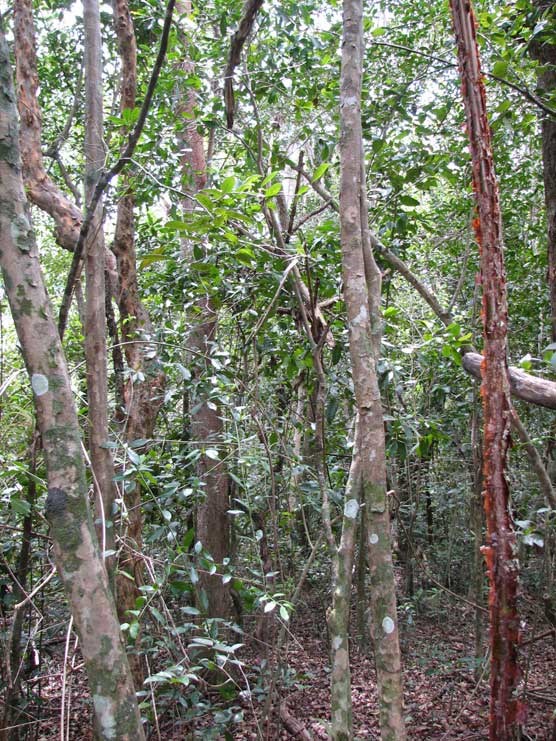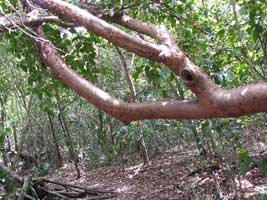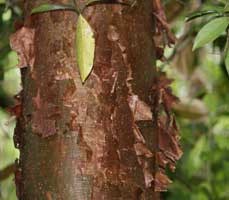
A hardwood hammock is a habitat that is found on higher elevations, making it (like the pinelands) a dry habitat. To walk into a hardwood hammock is to walk through a shady tropical forest. Hardwoods are broad leaved trees that grow well in the Everglades. If you were to look straight up, you might have trouble seeing the sun and sky because of all the trees growing close together. Their branches and leaves crisscross so much they create a canopy, or cover, above your head. These tree branches help keep the hammocks shady and cool. If you’re out in the Everglades on a hot day, try looking for a nice hardwood hammock to relax and cool off in. 
While cooling off in a hammock, you can spend some time exploring. You could find really interesting plants, animals, and even (if you're really lucky) maybe some ancient artifacts. Did you know that the Native Americans living in the Everglades frequently lived within the hammock habitats? Archeologists have found evidence of their presence based on artifacts such as pottery pieces and shell tools found in these hammocks. 
Once you walk into the shady hammock, you’ll notice there are a great many species of plants to see. One of the easiest tree species to recognize is the Gumbo Limbo tree because of its red, flaky bark. When trying to identify this tree, look for characteristics/traits that are easy to see from a distance, like its red bark! 
The red part is paper thin and peels off easily, giving it the appearance of being sunburned. These physical characteristics of the gumbo limbo tree soon led it to be known as the tourist tree or the sunburned tree. Now that you’ve seen the Gumbo Limbo, do you think you could identify this tree out in nature? Why not try your tree identification skills by taking a look at the picture located at the very top of this page? There is a Gumbo Limbo tree mixed in with the other tree species. 
While exploring the hardwood hammocks you need to be careful where you step. You don't want to fall into a solution hole like the one pictured to the right. Solution holes like these are often found in the hardwood hammocks. When the wet season arrives, these holes fill with water and help give the hammocks added protection from possible fires (like a moat protecting a castle). Sometimes, animals like the American alligator will make these small wet ponds their homes too. Solution holes are formed gradually over time when limestone erodes or is dissolved. This process is caused by a solution, or mixture, of rainfall and the weak acid produced by the decaying leaves found all over the hammock floor. Maybe you can join the many treasure hunters that used to visit these places.
Do you know what it is? It's the Tree Snail! 
There are so many different species of these snails and they come in so many different colors and patterns, that it is fun to seek them out and collect pictures of each one. Collectors used to remove the snails from the hardwood hammock so they could add shells to their collection, however this drastically reduced the population of tree snails making it harder to find the snails. Today the snails are protected and now it's illegal to take the snails. Instead many people today collect photographs of each snail species they find. Come take a look at some of the photo treasures I found on my walks through the hammocks! 
To return to the previous page click on Habitat and to return to the main |
Last updated: June 29, 2020
